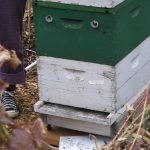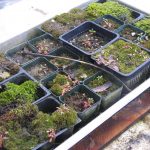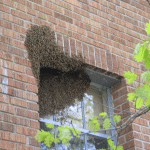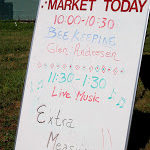 Last summer I was introduced to Glen Andresen, a local bee-keeper, at the Lents Farmers Market. He gave a short overview of bee-keeping and I signed up to receive notices about future workshops he typically hosts in the Spring. I was lucky to snag a spot in one of his recent “Intro to Beekeeping” workshops in Portland a couple weeks ago, which eventually sold out.
Last summer I was introduced to Glen Andresen, a local bee-keeper, at the Lents Farmers Market. He gave a short overview of bee-keeping and I signed up to receive notices about future workshops he typically hosts in the Spring. I was lucky to snag a spot in one of his recent “Intro to Beekeeping” workshops in Portland a couple weeks ago, which eventually sold out.
The workshop consisted of about three hours of lecture, slide show, and reviewing handouts. I was at the edge of my seat the whole time, frantically scribbling notes. The fourth hour of the workshop was a field trip to Glen’s house nearby, where we has numerous hives. I was surprised actually to count about six or seven in his relatively small city lot.
Glen covered a world of information in a short amount of time. I think it’s a lot easier to give a workshop on urban chickens than urban bees, but perhaps that is why the world of bees is so much more interesting. I love my chickens, but complex creatures they are not. Bee colonies, however, are incredibly complex with everyone clearly understanding their role in the colony and some good doses of unpredictability thrown into the mix.
This is going to be a multi-part post, but for this portion I want to share what I learned about the roles bees play in a colony.
The Queen:
There is only one queen bee in a colony. She is much larger than the female worker bees and longer in shape than the drones (males). She is typically the only reproducing female in the colony, laying up to 1,500 eggs per day and approximately 350,000 eggs per year. She can live up to age five, but she is typically replaced her second year.
It takes several days after the queen is born for her to be able to fly. She is not a very good flier due to her poor eyesight. When the temperature reaches about 70 degrees, she will take her “virgin flight”. This is the only time she leaves the colony. She visits a nearby drone congregation area (DCA) and will mate with up to twenty drone bees – what a slut! She stores the sperm for her entire life, which she uses to lay female worker bee eggs. No sperm is required for drones (males).
The Workers:
These bees are all female, but smaller in size than the queen. They represent about 99% of the colony and can be broken down into three sub groups: Nurse, House, and Field bees.
Nurse bees are one-twelve days old. They are in charge of cleaning out cells where eggs are hatched, feeding the eggs, etc.
House bees are 10-20 days old and are responsible for building comb, removing the queen feces (everyone else goes outside the hive to defecate), removing dead bees, guarding the hive, control the climate (they shiver to generate heat), accepting pollen and nectar from the forager bees.
Field/Forager bees are 20 days old and up, living somewhere from 30-45 days total. They collect nectar/pollen, water, plant resins.
Drones:
All male bees, representing less than 1% of the colony’s population. These poor boys are only good for one thing and get kicked out of the hive in the fall, when they are no longer needed for reproduction. They also die after mating. Sorry boys!
The continuation of this post will talk more about bees, their reproduction, housing needs, etc.





 This cluster was about the siz
This cluster was about the siz




 I start with a
I start with a


Wow! I did not realize what a total matriarchy the bee colony was. Thanks for this article. Bee keeping has been on my mind for a few years now. I plan on giving it a try at some point in my life.